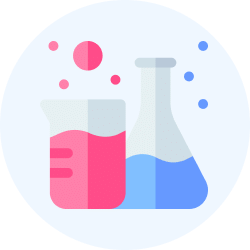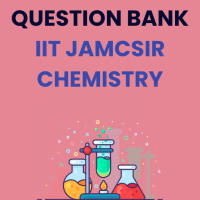Chemistry Exam > Chemistry Questions > An example of a reversible reaction is:a)Pb(N...
Start Learning for Free
An example of a reversible reaction is:
- a)Pb(NO3)2 (aq) + 2NaI (aq) = PbI2(s) + 2NaNO3(aq)
- b)AgNO3(aq) + HCl(aq) = AgCl(s) + HNO3(aq)
- c)2Na(s) + 2H2O(l) = 2NaOH(aq) + H2(g)
- d)KNO3(aq) + NaCl(aq) = KCl(aq) + NaNO3(aq)
Correct answer is option 'D'. Can you explain this answer?
Most Upvoted Answer
An example of a reversible reaction is:a)Pb(NO3)2 (aq) + 2NaI (aq) = P...
Weak acids and bases may undergo reversible reactions. For example, carbonic acid and water react this way:
H2CO3 (l) + H2O(l) ⇌ HCO−3 (aq) + H3O+(aq)
Another example of a reversible reaction is:
N2O4 ⇆ 2 NO2
Two chemical reactions occur simultaneously:
N2O4 → 2 NO2
2 NO2 → N2O4
Reversible reactions do not necessarily occur at the same rate in both directions, but they do lead to an equilibrium condition. If dynamic equilibrium occurs, the product of one reaction is forming at the same rate as it is used up for the reverse reaction. Equilibrium constants are calculated or provided to help determine how much reactant and product is formed.
The equilibrium of a reversible reaction depends on the initial concentrations of the reactants and products and the equilibrium constant, K.
Free Test
FREE
| Start Free Test |
Community Answer
An example of a reversible reaction is:a)Pb(NO3)2 (aq) + 2NaI (aq) = P...
Reversible Reaction Example
A reversible reaction is a chemical reaction in which the products can react to form the original reactants. An example of a reversible reaction is:
KNO3(aq) + NaCl(aq) ⇌ KCl(aq) + NaNO3(aq)
Explanation:
Reactants:
- Potassium Nitrate (KNO3) in aqueous form
- Sodium Chloride (NaCl) in aqueous form
Products:
- Potassium Chloride (KCl) in aqueous form
- Sodium Nitrate (NaNO3) in aqueous form
In this reaction, the forward reaction is the combination of KNO3 and NaCl to form KCl and NaNO3. The reverse reaction is the combination of KCl and NaNO3 to form KNO3 and NaCl.
This reaction is reversible because both the forward and reverse reactions occur at the same rate. The equilibrium constant (Kc) for this reaction is equal to 1, indicating that the concentrations of the reactants and products are equal at equilibrium.
Overall, this reaction demonstrates the concept of chemical equilibria and how reactions can be reversible.
A reversible reaction is a chemical reaction in which the products can react to form the original reactants. An example of a reversible reaction is:
KNO3(aq) + NaCl(aq) ⇌ KCl(aq) + NaNO3(aq)
Explanation:
Reactants:
- Potassium Nitrate (KNO3) in aqueous form
- Sodium Chloride (NaCl) in aqueous form
Products:
- Potassium Chloride (KCl) in aqueous form
- Sodium Nitrate (NaNO3) in aqueous form
In this reaction, the forward reaction is the combination of KNO3 and NaCl to form KCl and NaNO3. The reverse reaction is the combination of KCl and NaNO3 to form KNO3 and NaCl.
This reaction is reversible because both the forward and reverse reactions occur at the same rate. The equilibrium constant (Kc) for this reaction is equal to 1, indicating that the concentrations of the reactants and products are equal at equilibrium.
Overall, this reaction demonstrates the concept of chemical equilibria and how reactions can be reversible.

|
Explore Courses for Chemistry exam
|

|
Question Description
An example of a reversible reaction is:a)Pb(NO3)2 (aq) + 2NaI (aq) = PbI2(s) + 2NaNO3(aq)b)AgNO3(aq) + HCl(aq) = AgCl(s) + HNO3(aq)c)2Na(s) + 2H2O(l) = 2NaOH(aq) + H2(g)d)KNO3(aq) + NaCl(aq) = KCl(aq) + NaNO3(aq)Correct answer is option 'D'. Can you explain this answer? for Chemistry 2025 is part of Chemistry preparation. The Question and answers have been prepared according to the Chemistry exam syllabus. Information about An example of a reversible reaction is:a)Pb(NO3)2 (aq) + 2NaI (aq) = PbI2(s) + 2NaNO3(aq)b)AgNO3(aq) + HCl(aq) = AgCl(s) + HNO3(aq)c)2Na(s) + 2H2O(l) = 2NaOH(aq) + H2(g)d)KNO3(aq) + NaCl(aq) = KCl(aq) + NaNO3(aq)Correct answer is option 'D'. Can you explain this answer? covers all topics & solutions for Chemistry 2025 Exam. Find important definitions, questions, meanings, examples, exercises and tests below for An example of a reversible reaction is:a)Pb(NO3)2 (aq) + 2NaI (aq) = PbI2(s) + 2NaNO3(aq)b)AgNO3(aq) + HCl(aq) = AgCl(s) + HNO3(aq)c)2Na(s) + 2H2O(l) = 2NaOH(aq) + H2(g)d)KNO3(aq) + NaCl(aq) = KCl(aq) + NaNO3(aq)Correct answer is option 'D'. Can you explain this answer?.
An example of a reversible reaction is:a)Pb(NO3)2 (aq) + 2NaI (aq) = PbI2(s) + 2NaNO3(aq)b)AgNO3(aq) + HCl(aq) = AgCl(s) + HNO3(aq)c)2Na(s) + 2H2O(l) = 2NaOH(aq) + H2(g)d)KNO3(aq) + NaCl(aq) = KCl(aq) + NaNO3(aq)Correct answer is option 'D'. Can you explain this answer? for Chemistry 2025 is part of Chemistry preparation. The Question and answers have been prepared according to the Chemistry exam syllabus. Information about An example of a reversible reaction is:a)Pb(NO3)2 (aq) + 2NaI (aq) = PbI2(s) + 2NaNO3(aq)b)AgNO3(aq) + HCl(aq) = AgCl(s) + HNO3(aq)c)2Na(s) + 2H2O(l) = 2NaOH(aq) + H2(g)d)KNO3(aq) + NaCl(aq) = KCl(aq) + NaNO3(aq)Correct answer is option 'D'. Can you explain this answer? covers all topics & solutions for Chemistry 2025 Exam. Find important definitions, questions, meanings, examples, exercises and tests below for An example of a reversible reaction is:a)Pb(NO3)2 (aq) + 2NaI (aq) = PbI2(s) + 2NaNO3(aq)b)AgNO3(aq) + HCl(aq) = AgCl(s) + HNO3(aq)c)2Na(s) + 2H2O(l) = 2NaOH(aq) + H2(g)d)KNO3(aq) + NaCl(aq) = KCl(aq) + NaNO3(aq)Correct answer is option 'D'. Can you explain this answer?.
Solutions for An example of a reversible reaction is:a)Pb(NO3)2 (aq) + 2NaI (aq) = PbI2(s) + 2NaNO3(aq)b)AgNO3(aq) + HCl(aq) = AgCl(s) + HNO3(aq)c)2Na(s) + 2H2O(l) = 2NaOH(aq) + H2(g)d)KNO3(aq) + NaCl(aq) = KCl(aq) + NaNO3(aq)Correct answer is option 'D'. Can you explain this answer? in English & in Hindi are available as part of our courses for Chemistry.
Download more important topics, notes, lectures and mock test series for Chemistry Exam by signing up for free.
Here you can find the meaning of An example of a reversible reaction is:a)Pb(NO3)2 (aq) + 2NaI (aq) = PbI2(s) + 2NaNO3(aq)b)AgNO3(aq) + HCl(aq) = AgCl(s) + HNO3(aq)c)2Na(s) + 2H2O(l) = 2NaOH(aq) + H2(g)d)KNO3(aq) + NaCl(aq) = KCl(aq) + NaNO3(aq)Correct answer is option 'D'. Can you explain this answer? defined & explained in the simplest way possible. Besides giving the explanation of
An example of a reversible reaction is:a)Pb(NO3)2 (aq) + 2NaI (aq) = PbI2(s) + 2NaNO3(aq)b)AgNO3(aq) + HCl(aq) = AgCl(s) + HNO3(aq)c)2Na(s) + 2H2O(l) = 2NaOH(aq) + H2(g)d)KNO3(aq) + NaCl(aq) = KCl(aq) + NaNO3(aq)Correct answer is option 'D'. Can you explain this answer?, a detailed solution for An example of a reversible reaction is:a)Pb(NO3)2 (aq) + 2NaI (aq) = PbI2(s) + 2NaNO3(aq)b)AgNO3(aq) + HCl(aq) = AgCl(s) + HNO3(aq)c)2Na(s) + 2H2O(l) = 2NaOH(aq) + H2(g)d)KNO3(aq) + NaCl(aq) = KCl(aq) + NaNO3(aq)Correct answer is option 'D'. Can you explain this answer? has been provided alongside types of An example of a reversible reaction is:a)Pb(NO3)2 (aq) + 2NaI (aq) = PbI2(s) + 2NaNO3(aq)b)AgNO3(aq) + HCl(aq) = AgCl(s) + HNO3(aq)c)2Na(s) + 2H2O(l) = 2NaOH(aq) + H2(g)d)KNO3(aq) + NaCl(aq) = KCl(aq) + NaNO3(aq)Correct answer is option 'D'. Can you explain this answer? theory, EduRev gives you an
ample number of questions to practice An example of a reversible reaction is:a)Pb(NO3)2 (aq) + 2NaI (aq) = PbI2(s) + 2NaNO3(aq)b)AgNO3(aq) + HCl(aq) = AgCl(s) + HNO3(aq)c)2Na(s) + 2H2O(l) = 2NaOH(aq) + H2(g)d)KNO3(aq) + NaCl(aq) = KCl(aq) + NaNO3(aq)Correct answer is option 'D'. Can you explain this answer? tests, examples and also practice Chemistry tests.

|
Explore Courses for Chemistry exam
|

|
Signup for Free!
Signup to see your scores go up within 7 days! Learn & Practice with 1000+ FREE Notes, Videos & Tests.























